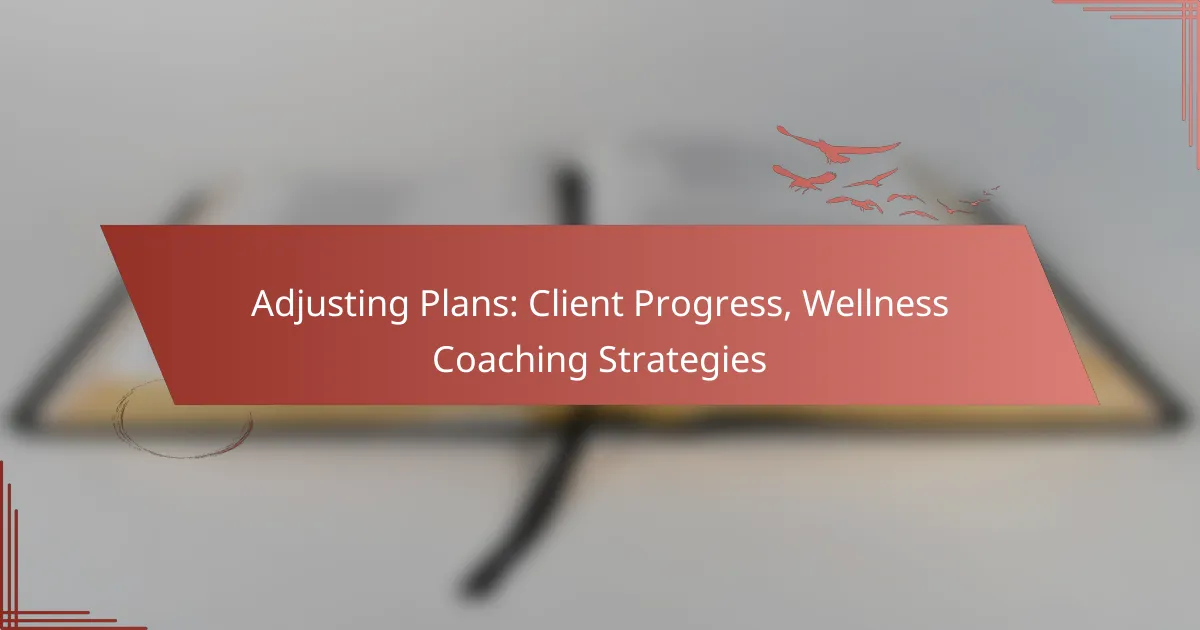In wellness coaching, tracking client progress is crucial for tailoring effective strategies that align with individual goals. By utilizing various tools and actively listening to client feedback, coaches can adjust plans to enhance outcomes and ensure a personalized approach that fosters overall well-being.

How can clients track their progress in wellness coaching?
Clients can track their progress in wellness coaching by utilizing various tools and strategies that monitor their health and wellness goals. Effective tracking not only provides insight into their journey but also helps in adjusting plans as needed for better outcomes.
Progress tracking tools
Progress tracking tools can include mobile apps, wearable devices, and online platforms that monitor health metrics such as weight, activity levels, and nutrition. Popular apps like MyFitnessPal or Fitbit allow clients to log their daily activities and food intake, providing visual feedback on their progress.
When choosing a tool, consider ease of use and compatibility with your lifestyle. Some clients may prefer simple journals or spreadsheets, while others might benefit from more sophisticated technology that offers real-time data analysis.
Regular check-ins
Regular check-ins with a wellness coach are essential for assessing progress and making necessary adjustments. These meetings can be scheduled weekly or bi-weekly, allowing clients to discuss their experiences, challenges, and successes.
During check-ins, coaches can provide personalized feedback and motivation, helping clients stay accountable. It’s beneficial to prepare specific questions or topics to discuss, ensuring that each session is productive and focused on progress.
Goal-setting frameworks
Utilizing goal-setting frameworks like SMART (Specific, Measurable, Achievable, Relevant, Time-bound) can enhance clarity and focus in wellness coaching. Clients should set clear and realistic goals that can be tracked over time, such as aiming to exercise three times a week or reducing sugar intake.
Regularly revisiting and adjusting these goals based on progress can help maintain motivation and ensure that clients are on the right path. It’s important to celebrate small victories along the way to foster a positive mindset.
Client feedback mechanisms
Implementing client feedback mechanisms allows for continuous improvement in the coaching process. Clients can provide feedback through surveys, one-on-one discussions, or digital platforms that track their satisfaction and progress.
Encouraging open communication helps coaches understand what strategies are working and which ones may need adjustment. This feedback loop is crucial for tailoring the coaching experience to meet individual needs and preferences effectively.

What wellness coaching strategies are most effective?
Effective wellness coaching strategies focus on personalized approaches that cater to individual needs and goals. These strategies often include tailored coaching plans, behavioral change techniques, and mindfulness practices that collectively enhance client progress and overall well-being.
Personalized coaching plans
Personalized coaching plans are designed to meet the unique needs of each client. These plans typically involve an initial assessment to identify goals, challenges, and preferences, allowing coaches to create a roadmap that aligns with the client’s lifestyle and aspirations.
For instance, a client aiming to lose weight might receive a plan that includes specific dietary recommendations, exercise routines, and progress tracking methods. Regular check-ins help adjust the plan as needed, ensuring it remains relevant and effective.
Behavioral change techniques
Behavioral change techniques focus on modifying habits and routines to support wellness goals. Common methods include setting SMART (Specific, Measurable, Achievable, Relevant, Time-bound) goals, using positive reinforcement, and implementing accountability measures.
For example, a coach might encourage a client to track their daily water intake and reward themselves for meeting hydration goals. This approach helps clients build sustainable habits over time, making it easier to achieve long-term wellness.
Mindfulness practices
Mindfulness practices involve techniques that promote awareness and presence, which can significantly enhance mental and emotional well-being. These practices may include meditation, deep breathing exercises, and mindful eating, all aimed at reducing stress and improving focus.
Clients can start with short daily sessions, gradually increasing the duration as they become more comfortable. Incorporating mindfulness into daily routines can lead to better decision-making and increased resilience against stressors.

How to adjust wellness plans based on client feedback?
Adjusting wellness plans based on client feedback is essential for ensuring that the strategies remain effective and relevant. By actively listening to clients and analyzing their experiences, coaches can make informed modifications that enhance overall progress and satisfaction.
Incorporate client input
Incorporating client input involves actively seeking feedback on their experiences with the wellness plan. This can be done through regular check-ins, surveys, or informal conversations. Understanding their preferences and challenges allows for a more personalized approach.
For instance, if a client feels overwhelmed by certain exercises, consider discussing alternatives that align better with their comfort level. This not only fosters a supportive environment but also encourages clients to remain engaged in their wellness journey.
Evaluate progress metrics
Evaluating progress metrics is crucial for understanding how well clients are responding to their wellness plans. Use a combination of qualitative feedback and quantitative data, such as weight changes, fitness levels, or mood improvements, to assess effectiveness.
Regularly review these metrics, perhaps monthly or quarterly, to identify trends and areas needing adjustment. If a client is not meeting their goals, it may indicate that the plan requires modification to better suit their needs.
Modify goals as needed
Modifying goals as needed ensures that wellness plans remain realistic and achievable. If clients are consistently struggling to meet their targets, it may be beneficial to reassess and adjust those goals to align with their current capabilities and lifestyle.
For example, if a client initially aimed to exercise five times a week but is only managing two, consider lowering the goal to three sessions. This adjustment can help maintain motivation and prevent feelings of failure, ultimately leading to better long-term adherence.

What are the key components of a successful wellness coaching program?
A successful wellness coaching program includes a comprehensive assessment of client needs, structured coaching sessions, and ongoing support resources. These components work together to create a tailored experience that promotes lasting health and wellness improvements.
Assessment of client needs
Assessing client needs is the foundation of an effective wellness coaching program. This involves understanding the client’s health history, lifestyle, goals, and any barriers they may face. A thorough assessment can include questionnaires, interviews, and health screenings.
Coaches should focus on both physical and emotional aspects of wellness. For instance, identifying stressors or motivational challenges can help in crafting a more personalized approach. Regular check-ins can also help adjust the assessment as clients progress.
Structured coaching sessions
Structured coaching sessions provide a framework for clients to engage with their wellness journey. These sessions should be scheduled consistently, typically weekly or bi-weekly, and last between 30 to 60 minutes. Each session should have clear objectives and actionable steps.
During these sessions, coaches can utilize various techniques such as goal setting, motivational interviewing, and skill-building exercises. It’s essential to adapt the structure based on client feedback and progress, ensuring that the sessions remain relevant and effective.
Ongoing support resources
Ongoing support resources are crucial for maintaining momentum in a wellness coaching program. This can include access to online tools, educational materials, and community support groups. Providing clients with resources like meal planning guides or exercise videos can enhance their experience.
Additionally, regular follow-ups via email or messaging can help clients stay accountable. Encouraging participation in local wellness events or workshops can also foster a sense of community and support, further enhancing their commitment to their wellness goals.

How do local wellness trends impact coaching strategies?
Local wellness trends significantly influence coaching strategies by shaping the focus areas and methods that wellness coaches adopt. Understanding these trends allows coaches to tailor their approaches to meet the specific needs and preferences of their clients within a community.
Community health initiatives
Community health initiatives often serve as a foundation for wellness coaching strategies. These programs may focus on promoting physical activity, healthy eating, or mental well-being, and they can provide valuable resources and support for coaches and clients alike.
For example, if a community emphasizes outdoor fitness events, a wellness coach might incorporate group activities like hiking or cycling into their sessions. Coaches should stay informed about local initiatives to align their strategies with community goals and enhance client engagement.
Additionally, collaborating with local health organizations can help coaches access tools and resources that support their clients’ wellness journeys. Coaches should consider attending community meetings or workshops to stay connected with ongoing initiatives and trends.
